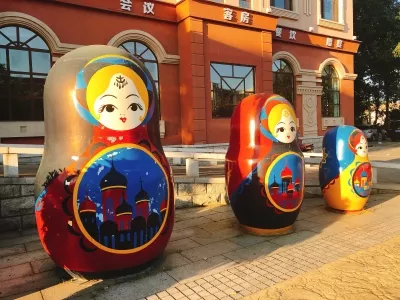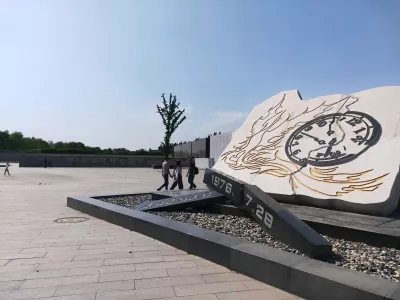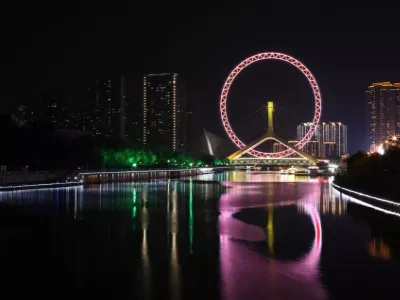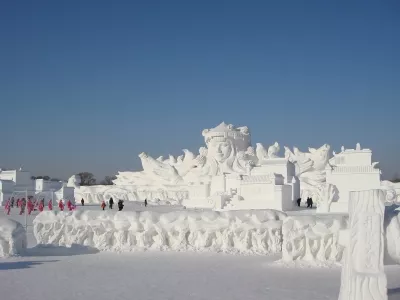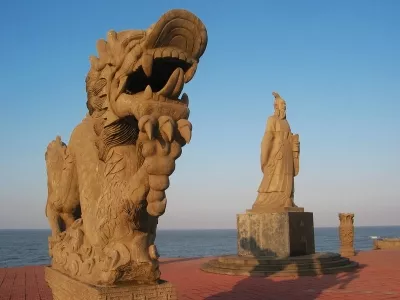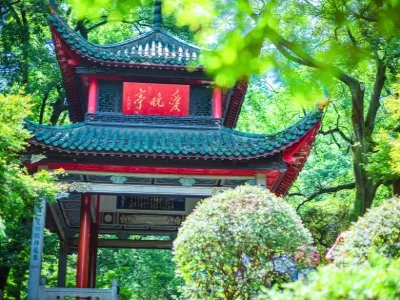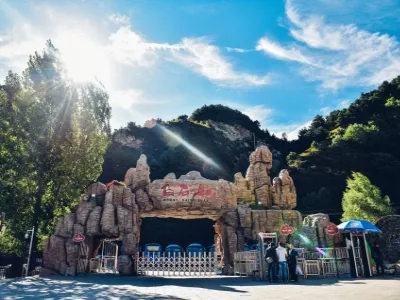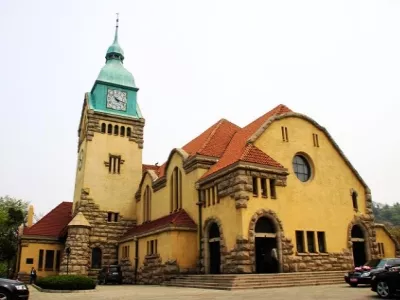Chengde is a vibrant and lively city known for its "blue sky, green earth, green mountains, beautiful waters, fresh air, smooth roads, clean city, and harmonious people". This garden-like city nestled amongst the mountains and waters is unveiling its beauty for all to see. Chengde's tourism is summarized by its proud locals as the "Three Imperial Crowns" and "Three Purple Cliffs Wonders". The "Three Imperial Crowns" refer to the world's largest existing imperial garden - Mountain Resort, the world's largest imperial temple complex - Outer Eight Temples, and the world's largest imperial hunting ground - Mulan Hunting Field. The "Three Purple Cliffs Wonders" are the Jinshanling section of the Great Wall showcasing the essence of the Purple Cliffs, the misty Mt. Wuling known as the "Natural Botanical Treasury of North China", and the spectacular Panlong Lake dubbed the "Little Li River beyond the Cliffs".
Known for its stunning natural scenery, Chengde is revealing its beauty as a garden city amongst mountains and waters. Famed attractions include the world's largest imperial sites - Mountain Resort, Outer Eight Temples, Mulan Hunting Field; and natural wonders - Jinshanling Great Wall, misty Mt. Wuling, and panoramic Panlong Lake. Chengde truly encapsulates China's splendor.
Experience the grandeur and grandeur of the Ming Great Wall
Jinshanling offers the most fully preserved stretch of China's majestic Ming Dynasty Great Wall. The formidable fortification winds along mountain ridges as far as the eye can see, with beacon towers interspersed along its sinuous path. Standing atop the ancient battlements at Jinshanling, a surge of adrenaline will hit as you gaze out at the wall's might and scale. Hiking to the top is an immense sense of accomplishment, with sheer cliffsides and peaks conquered on the ascent. This impressive section can only be fully appreciated from the experience of reaching its heights on foot. Let your imagination transport you back centuries, to envision fiery warning beacons and soldiers standing guard. Breathe deep as you take in panoramic vistas of the surrounding wilderness from these strategic ramparts. As you trace the contours of stone and brick beneath your fingers, reflect on the ingenuity and perseverance required to construct this massive engineering marvel. Jinshanling's remote setting and awe-inspiring Great Wall vistas make it a must-visit for adventurous history buffs.
Worship the world's tallest wooden thousand hands and thousand eyes Guanyin
The highlight of Chengde's Puning Temple is the awe-inspiring Great Hall of the Great Hero, home to the tallest wooden statue of Guanyin in the world. This serene place of Buddhist worship draws crowds who come to pay respect to the towering figure of Guanyin, the Goddess of Mercy and Compassion. Standing at nearly 22 meters tall, her sublime presence fills the hall. Approach with an open heart and observe the intricate details - the Bodhisattva's countless arms and eyes symbolizing her power to alleviate suffering. Lit by flickering candles, the aura of devotion is palpable as monks chant and pilgrims kneel in prayer. Pause to light incense at the altar and contemplate Guanyin's benevolence. Allow the sacred ambience to calm your spirit. Marvel at the masterful workmanship required to carve this colossal sculpture from 10 pieces of wood. This profoundly moving and tranquil sanctuary showcases unparalleled Tang Dynasty artistry. A visit to behold the magnificence of Puning Temple's Giant Guanyin is a highlight of any Chengde tour.
Watching Great Dramas in Chengde - "The Prosperous Dynasty: Kangxi Ceremony"
Cap off your imperial getaway in Chengde with an unforgettable evening at "The Glorious Dynasty: Kangxi's Grand Ceremony." This spectacular live show brings Qing Dynasty history to life through song, dance, martial arts, and special effects. As the first large-scale outdoor theater production focused on royal culture, it innovatively depicts the legendary reign of Emperor Kangxi. Spend your days touring Chengde's imperial summer resorts, gaining insight into royal lifestyle. Then journey to the theater after dark for a vivid dramatization of the Kangxi era's pivotal events. With 300 performers in elaborate costumes, thrilling battle reenactments, and dazzling visuals, this immersive experience transports you to 17th century China. Watch in awe as the emperor emerges from the glowing Forbidden City to host a lavish banquet. Marvel at warrior monks demonstrating their formidable Wudang martial arts skills. This action-packed theatrical performance perfectly complements Chengde's imperial sights. After a day of wandering palatial grounds, continue your royal adventure at this not-to-be-missed nighttime cultural spectacle.
In summer, bravely explore the Ice and Snow City and personally make ice sculptures
Beat the heat in one of China's magical Ice and Snow Worlds, where the temperature stays between -5°C and -8°C year-round. This frozen wonderland allows visitors to experience the magic of winter during the summer months. Marvel at intricate carved ice sculptures and glittering ice castles. Brave a bit of frostbite to go ice skating, sledding, or tubing like it's already winter. For warm weather visitors, it's the perfect place to bundle up in parkas and play in the snow on hot summer days. Kids and adults alike will love the interactive experience of donning gloves and grabbing chisels to carve mini ice sculptures as souvenirs under the guidance of an ice artist. Channel your inner Elsa as you chip away at the frozen blocks and bring your icy creations to life. Capture family photos that seem straight out of a snow globe against this sparkling icy backdrop. At China's magical Ice and Snow Worlds, enjoy winter activities and frosty fun no matter what the season. It's a cool way to beat the summer sizzle.
History
Chengde, formerly known as Rehe, has a long history and rich multi-ethnic cultural heritage. Archaeological evidence shows human activity in this region dating back to the Longshan Culture of the Central Plains. During the Warring States period, the State of Yan set up a prefectural government here. Successive dynasties since the Qin established local governments as well. From the Qin and Han dynasties to the Yuan and Ming periods, ethnic minorities including the Xiongnu, Xianbei, Khitan, Jurchens, and Mongols lived nomadic lives here. At the beginning of the Qing dynasty, the site of present-day Chengde was still a small village with dozens of households called Rehe Ying. In 1703, the Qing court built the Mountain Resort. Rehe Subprefecture was established in 1723, and renamed Chengde Zhou in 1733, meaning “to inherit the ancestors’ grace”. Since then, Chengde developed into a thriving city. However, from the accession of Xianfeng (1851) to the Kuomintang rule, Chengde declined and became desolate. After the Xinhai Revolution, the prefecture system was abolished and Rehe Special District was founded. Rehe Province was established in 1929 with Chengde as the capital. After the PRC's founding, Chengde transformed from decline to rebirth. In July 1993, the former Chengde City merged with Chengde Region.
Once called Rehe, Chengde has deep history and rich cultural heritage of various ethnic groups. From the Longshan Culture to nomadic tribes through dynasties, Chengde was a small village until the Qing made it a thriving city with the Mountain Resort. It later declined until the PRC revived it. Chengde's long history makes it a city of great cultural significance.
Best Travel Time
Touring Chengde is suitable for all four seasons, but considering its seasonal and beautiful natural scenery, April October is the best travel time. July to August is the best time to go to the Bashang Plateau, where there are wild flowers everywhere, the weather is cool, and the morning mist is diffuse. To experience the magnificent scenery of Mulan paddock in late autumn, where thousands of mountains are red and forests are stained, it is best to go from early September to early October.Dressing Guidelines
Chengde lies in the transitional zone between the Inner Mongolian Plateau and North China Plain, with a semi-arid, semi-humid continental monsoon climate and four distinct seasons. Summer days peak around 33°C while nights dip to 16°C, with big differences between day and night but overall cool weather. There is no hot season, so pack short sleeves and shorts along with two light jackets. Strong sunlight and dry air in August-September call for sun protection and skin care. Winter sees temperatures between -9°C to -18°C. Dress in 4-5 layers, with down jackets and thick cotton coats essential, plus hats, scarves and gloves for outdoor activities.
Located between the Inner Mongolian Plateau and North China Plain, Chengde has a dry, continental climate with cold winters and cool summers. Summer daytime highs reach 33°C while summer nights get as cool as 16°C, so pack layers along with sun protection. Winter temps range from -9°C to -18°C, demanding 4-5 layers of warm coats, jackets, hats, scarves and gloves. Chengde's seasonal climate requires packing layers appropriate for both cold and cool weather.

